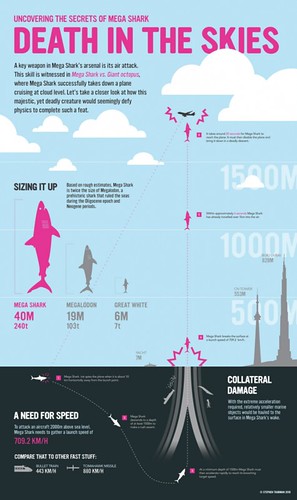March 10, 2010
How did Megashark knock down that airplane?
It's explained here

There is a bit of controversy about the numbers as shown in the comment by Caldwing
Comments are disabled.
Post is locked.

There is a bit of controversy about the numbers as shown in the comment by Caldwing
but you get the idea. The best comment has to come from the producer of the movie however:
You forgot to carry the ‘1′, but otherwise the math is solid.
Honestly, I think you spent more time on this chart then we did making the movie. But this was the best site yet on our little film. AWESOME!!!
Mega Thanks,
David
(Producer, MEGA SHARK VS. GIANT OCTOPUS)
Obviously he has never read DPUD.
Posted by: chad98036 at
12:20 PM
| Comments (13)
| Add Comment
Post contains 528 words, total size 3 kb.
15kb generated in CPU 0.0155, elapsed 0.1076 seconds.
62 queries taking 0.1021 seconds, 145 records returned.
Powered by Minx 1.1.6c-pink.
62 queries taking 0.1021 seconds, 145 records returned.
Powered by Minx 1.1.6c-pink.














Ok I actually did some calculations on this back when I first saw this incredible movie. I have revisited my calculations and come to some surprising conclusions.
As has been mentioned the true altitude of the aircraft would be about 10000 m, this is the value I used. The mass of the shark has been -woefully- underestimated however. I would agree with the assessment that the shark is about 140 m long. The largest great white ever caught was 6.4 m and about 3300 kg. increasing mass as the cube this gives us a weight of over 34000 kg. This makes sense since the shark is clearly the size of a large ocean going vessel, the likes of which routinely reach this discplacement.
When velocity is calculated in a vacuum however the mass of the shark is of course inconsequential. Using simple acceleration due to gravity the shark would have to be traveling at about 443 m/s, almost 1600 km/h, to reach this height.
Now the real surprise came when I went to try a rudimentary calculation of atmospheric friction. I used the standard drag formula, assuming the cross-sectional diameter of the shark moving head on to be about 30 m, and the area roughly circular. The coefficient of drag for sharks is actually very low, as discovered by my friend. I gave him a Cd of 0.1, allowing that his mouth is open. At sea-level, just as he leaves the water, the force due to air friction would be about 8.4 million Newtons. However, due to the incredible mass of the shark, this translates into only 0.244 m/s of vertical deceleration.
Now, although a true recalculation of required velocity would require more calculus then I care to bother with since the air friction will be constantly changing as altitude increases and velocity decreases, a quick estimate tells us that very little has changed. Even if that level of friction was constant, the deceleration would only increase from 9.81 m/s/s to 10.054 m/s/s, resulting in a final required velocity of about 449 m/s
This seems very counter-intuitive for me, and I still suspect I have gone wrong somewhere, but I cannot see where. I was expecting the air resistance to be totally insurmountable. But even a large increase in the drag coefficient would only bring the required velocity to… oh maybe over 500 m/s. If anyone has any thoughts or can point out obvious errors they would be welcome.
Of course, even getting to this speed underwater in the first place is a whole other ball of wax.